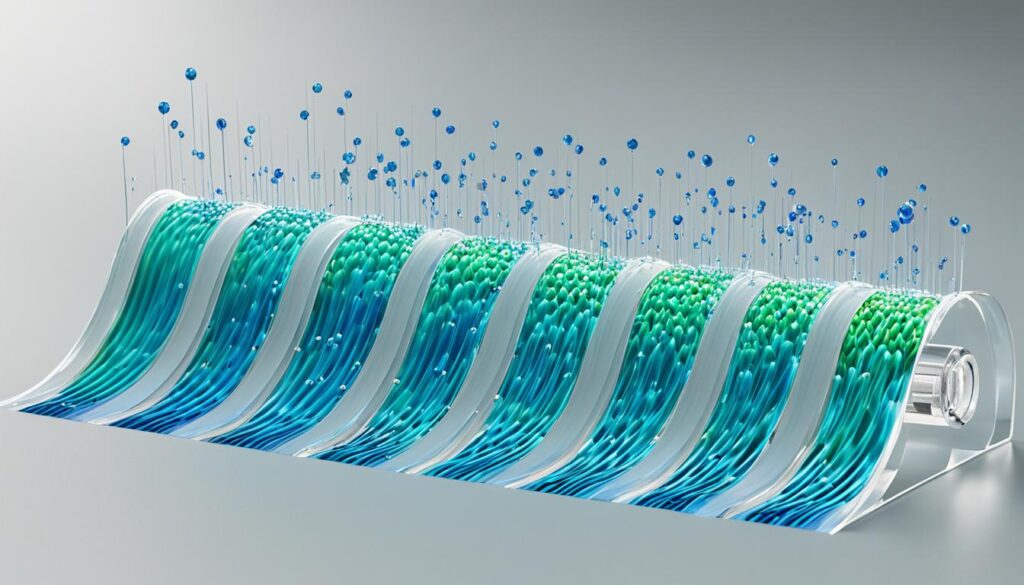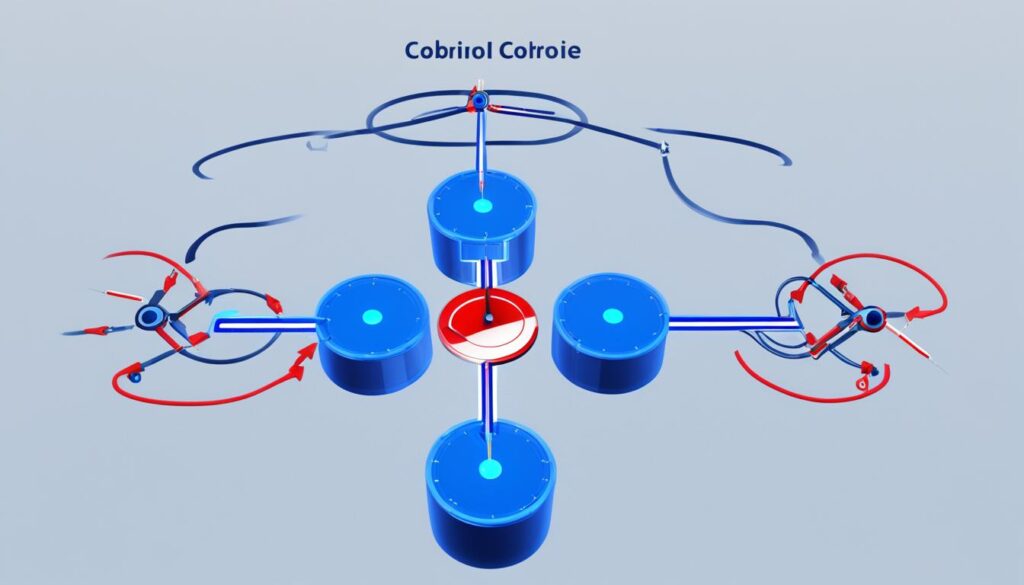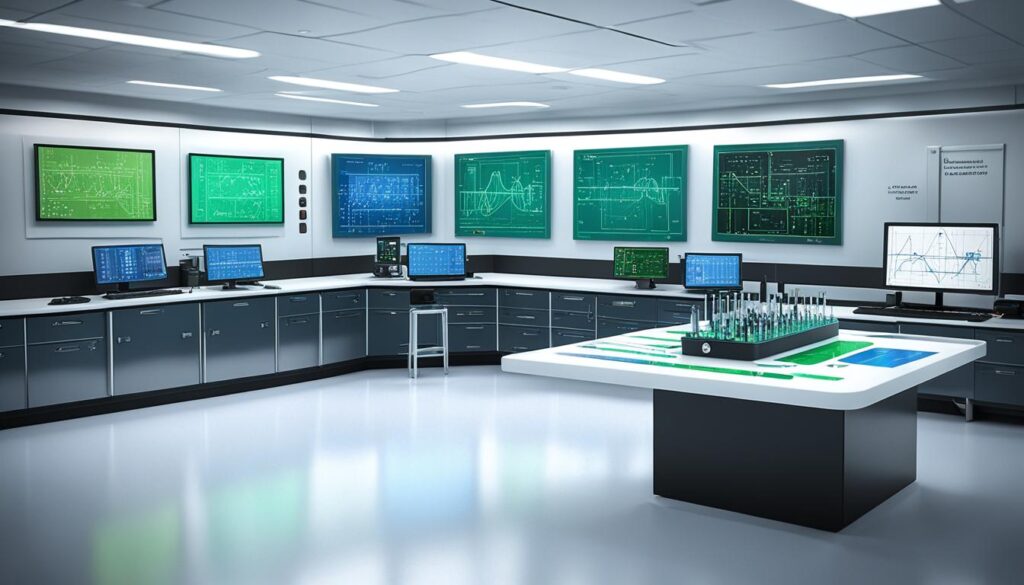Exciting news comes from the University of Würzburg about a major leap in precision metrology. They’ve changed how resistance measurements are done with the Quantum Anomalous Hall Effect. Professor Charles Gould and his team have discovered a way to measure electrical resistance with unmatched precision. This is using advanced materials crucial in many high-tech fields.
The Quantum Anomalous Hall Effect (QAHE) works without needing external magnetic fields. This simplicity transforms how experiments are set up and boosts the potential for tech advances. It affects everything from microchip designs to flight systems and sensors. This groundbreaking method not only improves how we measure electrical resistance. It also helps redefine the kilogram using basic electrical units. This is leading to a new quantum-based era in precision metrology, marked by incredible measurement accuracy.
Breaking Down the Quantum Anomalous Hall Effect
The field of Topological Insulators got a big boost with the finding of the Quantum Anomalous Hall Effect (QAHE). This discovery has truly changed Quantum Transport. Now, using special materials called Chern Insulators, measuring resistance is becoming more precise.
QAHE is unique because it creates a Hall effect without needing any external magnetic fields. This isn’t just for fun—it’s changing how resistance standards are thought about and used. Thanks to quantum mechanics, QAHE allows for exact resistance measurements. This precision is crucial for making new tech better.
As scientists dig deeper into QAHE, they’re seeing how it could change quantum measurements big time. It’s especially true when combining it with devices that measure the Josephson constant. This blend of fields might start a new phase in quantum electrical standards. It’s key for improving quantum resistance measuring and played a part in rethinking the kilogram based on Planck’s constant.
QAHE’s impact on improving resistance standards and metrology is huge. It’s paving the way for reliable electrical standards needed for the future’s advanced electronics. With ongoing research, QAHE is on track to change how we understand quantum transport and measurement accuracy.
Innovative Measurement Techniques Empowered by QAHE
The Quantum Anomalous Hall Effect (QAHE) is a big deal in quantum metrology. It’s paving the way for new precision instruments. The key here is the super accurate measurement of electrical resistance. Thanks to QAHE, the University of Würzburg’s team is making huge strides. They’re aiming for quantum standards of resistance with unmatched precision.

A huge leap has been the creation of new ways to measure things using QAHE. This solves big problems with measuring electrical resistance accurately. By using a special setup called a multi-terminal Corbino device, these scientists manage currents and shield against electric fields better. This step forward makes resistance measurements more reliable, even with higher currents.
Having this level of precision matters a lot, especially for national metrology institutes like the Physikalisch-Technische Bundesanstalt (PTB). With QAHE, these institutes can now use precision instruments that are more advanced. This is a big change. It brings together cutting-edge quantum science and real-world uses. Now, we’re looking at a new era for measuring electrical resistance and setting quantum standards.
QAHE working with practical metrology sets the stage for a bright future. It means quantum tools will soon make measuring electrical resistance a lot more accurate. These tools are set to boost the performance and trustworthiness of many industries. We’re talking about a major upgrade in how precision instruments and quantum standards work.
Quantum Anomalous Hall Effect
The search for Magnetic Topological Materials has started a new chapter. In this chapter, the Quantum Anomalous Hall Effect (QAHE) shines brightly. It’s changing how we measure resistance and much more. These materials have a special quality called Berry Curvature. It affects how electrons behave, which is key to QAHE. Unlike normal conductors, they let us measure resistance with unmatched accuracy.
In spintronics, we use the electron’s spin and its magnetism. QAHE’s discoveries are leading to big leaps forward. The strong edge states of QAHE work well even at high temperatures. They fit perfectly with quantum voltage standards, which need stable and precise references when hot.
But, using QAHE in resistance metrology isn’t easy yet. It works on very low currents to measure resistance right. This limitation is a big challenge for wider use. Everyone is hopeful that new discoveries in material science will make these materials even better. If we can make them work with higher currents, QAHE could become a key tool in precision measurement.
More research in this field could majorly improve how we measure resistance and design high-precision tools. Understanding and harnessing QAHE could help us advance technology. It relies on the complex world of quantum physics and its mysteries.

Multi-Terminal Corbino Device: Enhancing QAHE Applications
The arrival of the multi-terminal Corbino device is a big step forward in quantum physics and measuring resistance. It’s really important for QAHE (Quantum Anomalous Hall Effect) studies. This device can handle high currents without losing quantization stability. Many thought this combination was nearly impossible before.
This device makes it easier to manage electrochemical potentials in different parts of a system. Researchers can now use multiple currents at once. This helps avoid problems like backscattering. Backscattering used to make it hard to keep things stable at high currents.

The design of this device pushes past old limits in measuring resistance. It also makes the QAHE stronger. It does this by keeping the system stable, even with high electrical currents. This is a big step for using this technology in real-world tools, like creating new standards for quantum resistance.
The ongoing work on the multi-terminal Corbino device is key to QAHE research. Its success shows big progress in making accurate resistance measurements for high-tech tools. These tools need precise measurements to work their best.
QAHE’s Role in Defining Modern Metrological Standards
The exciting work of the Quantum Anomalous Hall Effect (QAHE) is changing precision measurement and quantum resistance metrology. It shows how its feature of not needing a magnetic field is key to improving modern metrological standards. This not only intrigues scientists but also plays a big role in changing the kilogram’s definition to rely on Planck’s constant.
QAHE and new measurement tools are starting a new chapter in metrology. They could bring voltage and resistance standards together into one tool. This is very important for understanding quantum resistance and voltage. It also helps precision tools like the Kibble balance become more stable and accurate.
With the new kilogram definition, QAHE has moved from a new idea to a practical tool in quantum resistance metrology. This change is huge for precision measurements and standards, marking QAHE as a key part of metrology’s future. As quantum technology gets better, QAHE’s role in measurement shows the big changes in understanding and using the constants that rule our world.

Collaboration and Precision: Path to Metrological Implementation
The Quantum Anomalous Hall Effect (QAHE) is changing precision metrology for the better. It’s a new era of quantum resistance standards. The team at the University of Würzburg and the Physikalisch-Technische Bundesanstalt (PTB) are leading this change. Their teamwork combines expertise and high-precision tools. This effort aims to improve resistance standards significantly.
This journey in metrology is about more than just science. It’s about pushing technology forward. QAHE works without an external magnetic field. Combined with the PTB’s rigorous testing, the aim is to create better standards for measuring resistance. These new standards will help in many fields, like sensor tech and advanced flight control.
Now, the task is to make sure these new quantum resistance standards are top-notch. The Quantum Anomalous Hall Effect sparks a vision of the future where precision is key. With strong collaboration and a focus on perfect measurements, QAHE is pivotal in enhancing science and technology. It’s leading us to a more reliable and precise future.
